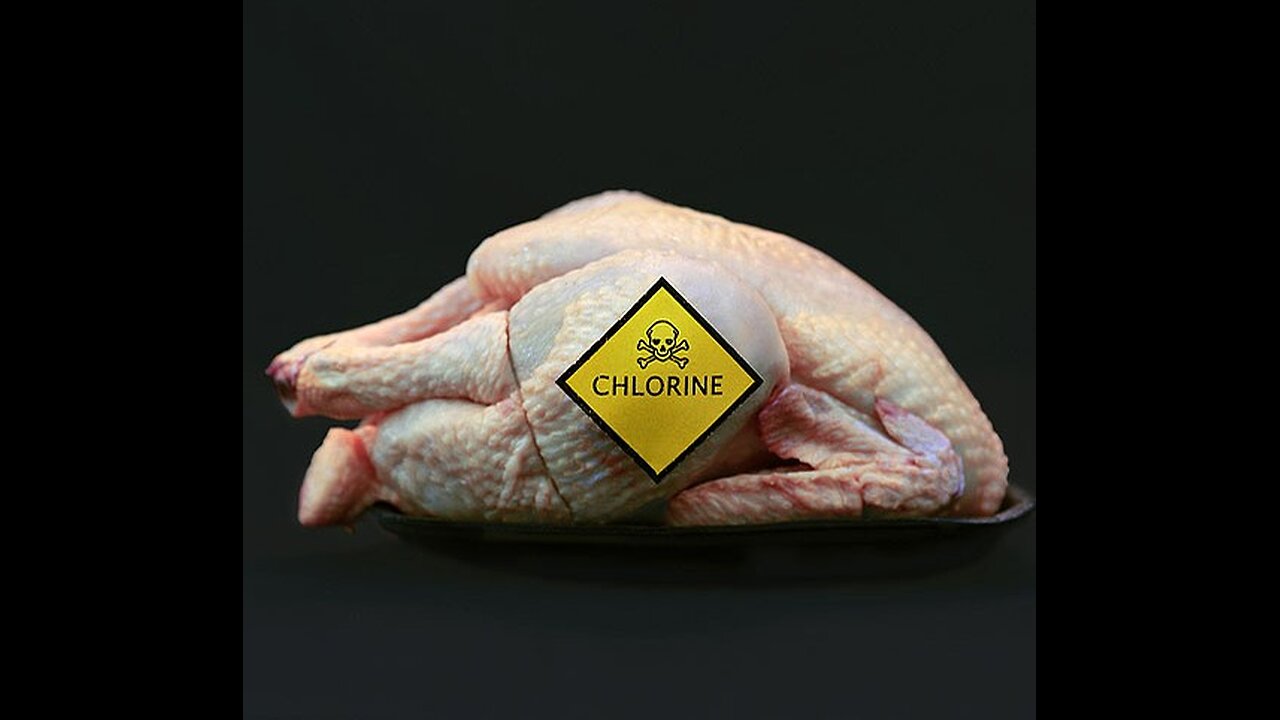Premium Only Content

Got Toxic Chicken?
It's important to clarify the information regarding "chlorine baths" and chicken processing in the U.S. Here's a breakdown:
Click to watch video: In Case You or Someone You Know Is Still Eating Costco Chickens
Chlorine Rinses:
It's more accurate to describe the process as using antimicrobial rinses, which may include chlorine-based solutions, rather than a "chlorine bath."
These rinses are used to reduce bacteria like Salmonella and Campylobacter on raw chicken.
The USDA approves the use of these antimicrobial treatments at safe levels.1
Safety:
Scientific studies and regulatory bodies like the USDA and FDA have determined that these practices, when done within approved limits, are safe.
The chlorine is used to sanitize, and the levels are controlled to minimize residues.
Prevalence:
While chlorine based solutions are used, the use of other antimicrobial solutions are also common.2 So it is not accurate to say that all chicken is dipped in a chlorine bath.
Also many plants are moving away from chlorine based solutions.
Consumer Concerns:
There have been consumer concerns and discussions about the use of these treatments, particularly when compared to practices in other regions like the European Union.
In summary, while antimicrobial treatments, including those using chlorine, are part of the chicken processing in the U.S., it's not accurate to say that all chicken is "dipped in a chlorine bath." These treatments are used to enhance food safety and are regulated by the USDA.3
Chlorine poisoning occurs when someone is exposed to a harmful amount of chlorine.1 This can happen through inhalation, ingestion, or skin contact.2 Here's a breakdown of key information:
Causes:
Inhalation:
Mixing chlorine-based cleaning products with other chemicals (especially ammonia or acids) can create toxic chlorine gas.3
Accidental releases of chlorine gas in industrial settings or swimming pools.4
Ingestion:
Swallowing chlorine-containing products like bleach.5
Skin or Eye Contact:
Exposure to concentrated chlorine solutions.
Symptoms:
The severity of symptoms depends on the amount and duration of exposure.6 Common symptoms include:
Respiratory:
Coughing7
Shortness of breath8
Chest pain9
Wheezing10
Fluid in the lungs (pulmonary edema)11
Eyes, Nose, and Throat:
Burning sensation12
Watery eyes13
Sore throat14
Blurred vision15
Skin:
Burning16
Redness17
Blisters18
Gastrointestinal:
Nausea19
Vomiting20
Abdominal pain21
Emergency Measures:
If inhaled:
Immediately move to fresh air.22
If on skin:
Remove contaminated clothing and wash the affected area with plenty of water.23
If in eyes:
Flush eyes with plenty of water for at least 15 minutes.
If swallowed:
Do not induce vomiting unless instructed by a medical professional.24
Seek immediate medical attention.
Call for Help:
Contact your local emergency number (such as 911) or poison control center immediately.25
Important Considerations:
Never mix chlorine-based cleaning products with other chemicals.26
Store chlorine-containing products safely, out of reach of children.
Ensure proper ventilation when using chlorine products.27
It's crucial to seek medical attention immediately if you suspect chlorine poisoning.
When discussing "detoxing" from chlorine, it's important to differentiate between:
Minimizing exposure effects: This refers to mitigating the immediate effects of chlorine on your skin, hair, and overall well-being, especially after swimming.
Systemic detoxification: This implies removing chlorine that may have been absorbed into the body.
Here's a breakdown of approaches:
Minimizing Exposure Effects:
After Swimming:
Rinse thoroughly: Immediately shower with clean water to wash off chlorine residue.
Chlorine-removal products: Use shampoos, conditioners, and body washes specifically designed to neutralize chlorine. These often contain vitamin C or other neutralizing agents.
Moisturize: Chlorine can dry out your skin and hair, so apply a good moisturizer afterward.
Vitamin C: Vitamin C neutralizes chlorine. You can use vitamin C powder dissolved in water and sprayed on the skin.
Hair Care:
Swimmers shampoos are widely available.
These shampoos are designed to remove chlorine and other pool chemicals.
Supporting Systemic Detoxification:
Hydration: Drinking plenty of water helps your body's natural detoxification processes.
Healthy Diet: A balanced diet rich in fruits, vegetables, and antioxidants supports overall health and detoxification.
Detox Baths:
Epsom salt baths can help soothe muscles and may aid in drawing out toxins.
Adding baking soda to your bath can also help neutralize chlorine.
Essential oils: Some people use essential oils like those in certain detoxifying blends, however, it is important to remember that these are not medically proven to remove chlorine from the body.
Important Notes:
While these methods can help minimize the effects of chlorine, it's crucial to remember that chlorine is generally safe at the levels used in pools and drinking water.
If you experience severe or persistent symptoms after chlorine exposure, consult a healthcare professional.
It is always best to speak to a doctor before beginning any detox practices.
I hope this information is helpful.
-
 2:52:55
2:52:55
Barry Cunningham
4 hours agoIT'S MOVIE NIGHT WITH BARRY!
43.3K23 -
 31:05
31:05
The Why Files
2 days agoPeru's Most Terrifying Mystery | The Face Peelers
47.2K41 -
 1:32
1:32
Gaming on Rumble
12 hours agoWhat is the Rumble Creator Program?!?! | Lvl UP
29.1K4 -
 1:50:49
1:50:49
Flyover Conservatives
1 day ago9/11 on Steroids: What’s Coming This Fall? - Bo Polny | FOC Show
40.6K7 -
 1:01:28
1:01:28
Precision Rifle Network
10 hours agoS4E27 Guns & Grub - Let's Talk About Gas Guns
25.5K2 -
 59:29
59:29
The Charlie Kirk Show
5 hours agoTHOUGHTCRIME Ep. 96 — The Great Flag Burning Debate
52.3K34 -
 57:56
57:56
The Mel K Show
5 hours agoMel K & General Mike Flynn | Betrayal of a Nation: Soros’ NATO World Order | 8-28-25
30.3K28 -
 2:13:31
2:13:31
Joker Effect
4 hours agoInterviewing BEN JAMMINS! A personality with over 1 BILLION gif views. Let's give him a warm welcome
17K1 -
 11:37
11:37
Robbi On The Record
11 hours agoThe Devil is in the Branding..
16.3K9 -
 1:26:44
1:26:44
Savanah Hernandez
6 hours agoWhy Gen-Z Is So Radicalized Against Immigration
15.5K9